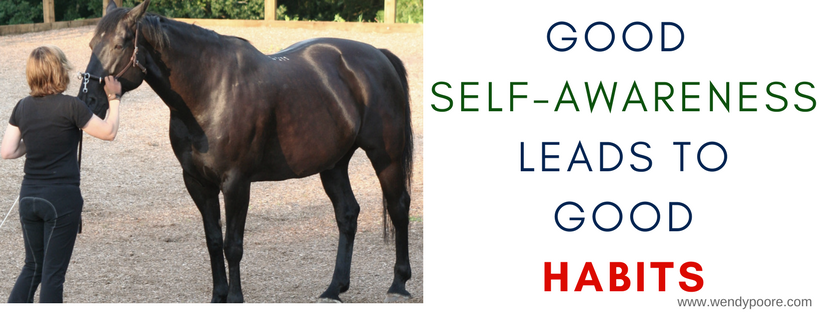|
Our brains are constantly developing, even into old age. It only takes a few repetitions of a certain behaviour to create a neural pathway of nerve calls in our brain. Every time that behaviour is repeated those pathways become stronger and wider and gradually they become superhighways and a habit or addiction is formed. It is just the same for horses.
The definition in the Oxford dictionary for ‘Habit’ is: 1. A settled or regular tendency or practice, especially one that is hard to give up. ‘he has an annoying habit of interrupting me’ ‘good eating habits’ ‘we stayed together out of habit’ 1.1 Informal An addictive practice, especially one of taking drugs. 1.2 Psychology An automatic reaction to a specific situation A behaviour repeated just 3 times can form a habit. Habits and routines can be very beneficial. A large proportion of our everyday actions are habits and 95% of our brain activity is unconscious. In animal training we strive to create good habits by using operant or classical conditioning to teach desirable behaviours in response to controlled stimulus. As horse trainers we aim to bring ourselves, and our horses, to a level of unconscious competence, a state where we have developed a high level of skill that has become second nature; good habits we can do without even thinking. A lot of practice and many many repetitions will form the mental superhighways we need. Bad habits are formed in the same way as good ones. These could be our own, or our horse could have developed a bad habit, even though the original stimulus that caused the behaviour in the first place has long gone. Deeply ingrained habits can be difficult to change but being aware of the way neural pathways are formed can help. Ignoring an undesirable behaviour often just makes it worse because the horse continues to practice the behaviour which in turn strengthens the neural pathway. The trick is not so much to stop a bad habit but to replace it with a good one. “If you always do what you’ve always done, you’ll always get what you’ve always got.” - Henry Ford A change in routine will help to change the circumstances that lead up to a bad habit. That means noticing what happens before what happens happens - and changing your response to it. Interrupting the chain or pattern of behaviour. Bad habits in horses are almost always inadvertently created by the handler or trainer. The causes can be obvious, or very subtle: too much pressure, constant pressure, lack of release of pressure, poorly timed aids, lack of leadership, misjudged timing or dosing of food rewards or otherwise somehow unintentionally reinforcing an undesirable behaviour, and all of these can be due to a lack of self-awareness. The best prevention is to stop bad habits from forming in the first place. To avoid unintentionally reinforcing undesired behaviour we need to be self-aware; to notice our own habits - all the time. Not only what we are doing but what we are thinking; how we think and when; our attitude to ourselves, our horse and to others; our physical way of moving; what our inner voice is telling us. All these things can be habitual and they massively affect our horse when we come to train him. Finding self-awareness is about constantly observing ourselves and our actions. But it must be done without judgement, and without beating ourselves up or making ourselves feel bad or wrong. This includes noticing things like:
Let’s help our horses out by making it a habit to notice our own habits, and be proactive to change them into habits that will empower us and improve our training as well as our lives. There is a mine of valuable information about training horses and dealing with undesired behaviours, easily accessible within the Straightness Training Mastery course. More information here. The list of Straightness Training Instructors worldwide is here.
6 Comments
tina
6/2/2018 09:00:29 am
I always loved your neat way to propose teaching and to explain. Very "pathed", quite personal. This article is AWESOME. Thank you.
Reply
Wendy Poore
6/2/2018 11:14:25 am
Thank you, Tina, so great that you enjoyed it. :)
Reply
Jill Griffith
6/2/2018 04:30:13 pm
Great advice. Just got myself a Pixio so I can record my bad habits and to then hopefully correct them 😄
Reply
Wendy Poore
7/2/2018 12:19:57 am
Brilliant, Jill, and that is an excellent way to notice our own habits and how our horse responds to them.
Reply
Jill
22/2/2018 10:46:25 pm
This is a fabulous article. Helpful, straight forward and understandable on all levels. Thank you Wendy.
Reply
Wendy Poore
23/2/2018 10:11:28 pm
Awesome, Jill, great that you find it helpful. Thank you for the feedback.
Reply
Your comment will be posted after it is approved.
Leave a Reply. |
Details
AuthorWendy Poore |

 RSS Feed
RSS Feed